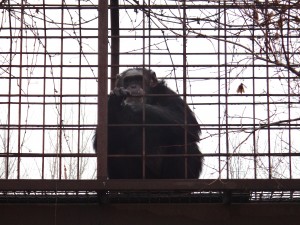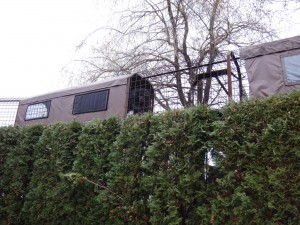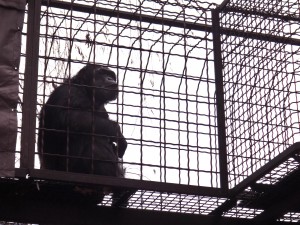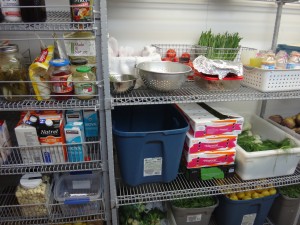Nat here! In 2011, I was surprised to learn from one of MDB’s bloggers, Shelly, that there was an amazing chimpanzee sanctuary here in Montreal (with Jane Goodall as a personal friend to the place, you KNOW it has to be amazing). We were permitted a private tour with Founder/Director Gloria Grow.
This past November, I had to chance to visit once again (and was lucky enough to bring my boyfriend as a guest). This time, Gloria’s brother Glenn showed us around. Here is my take on the experience:
____
Last month, I had the rare opportunity to visit a very special place about 30 minutes from Montreal.
Originally started as a sanctuary for neglected farm and domestic animals, Fauna Foundation is now known as Canada’s only (and deeply respected) chimpanzee sanctuary. It is a home for chimps from zoos, former ‘pets’ and from biomedical research labs. It is the only place in the world that welcomes HIV-infected animals. And it is truly one-of-kind.

In addition to 12 chimps, Fauna is also home to around 80 rescued animals, including monkeys, cows, a pig, geese, cats, dogs and more. The space spans 200 acres and is a government-dedicated nature reserve. As such, it also helps to repopulate local bird species and protect indigenous creatures.
____
We arrive at the Foundation in late November – the truck loaded with bags full of donations from the chimpanzee “wish list”. Things they might typically use in the wild: musical instruments, hair brushes, colouring books, hula hoops and DVDs! Kidding aside, these items provide enrichment. A crucial element in the lives of all creatures! It’s an indication of just how well-rounded the care at Fauna is. From enrichment items like these toys, to acres of outdoor space, things to climb, a fresh supply of healthy food (and treats!) and volunteers to keep them communicative and happy – the facilities here have been well tailored to chimp-taste.
It’s a far cry from this.
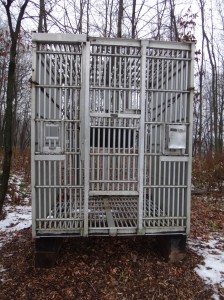
This lab cage offers a sobering reminder. It measures 5′ x 5′ x 7′. Many of the chimps at Fauna suffered for years in cages like this in biomedical research labs. NEVER leaving this confined space except when painfully darted and used for testing. It was a life of extreme fear, depression and pain.
Unlike other lab animals, which are killed soon after their “use”, chimps are abused for research repeatedly over decades. As sentient creatures with family bonds, intelligence, deep emotions – the mental and physical toll is indescribable. In fact, the ‘sweeter’ a chimp is, the greater the likelihood of it being subjected to further invasive research, because it is so ‘easy to work with’. This was the case with beautiful Pepper. She lived in a lab for 27 years, the victim of 306 traumatic ‘knockdowns’ (darting) and 36 punch liver biopsies among other atrocities, before coming to Fauna. Read her story here.
I am fortunate to have met Pepper before she died in 2012. She is the first chimp whose eyes I ever looked into, and it was something I find hard to describe. Her eyes and face held so much expression, it was like looking at another person. Which it truly was. In fact, chimpanzees are genetically closer to us than they are even to gorillas or orangutans (even though these are also apes). Founder and Director of Fauna Foundation, Gloria Grow had a special bond with Pepper and I am privileged to have briefly witnessed it up close.
___
Today, our first visit at Fauna is to the Monkey House. A huge and handsome baboon named Theo lives here. Wild-caught in Kenya as a baby and brought to a lab at Western University, he kept escaping his restraints so he was to be killed. Read his story here.
Eugene the Japanese Macaque (the kind you see enjoying hot springs in wildlife documentaries) – lived in a pet store for 27 years, as their ‘mascot’. He has been here since March and while we visit, comes out to shyly accept a few grapes to snack on. Read the poignant story about the day he was rescued, here.
Newton and Dara (2 Rhesus Macaques) and Sophie the Monkey House matriarch (a Capuchin) , round out the inhabitants. Sophie is 36 years old (she’s been at Fauna for 16 years). Sadly, at the time of this article, she is now struggling with her health and it may soon be time to say goodbye.
As we approach the Chimp House, we see treetop pathways. These chutes extend from the main facility to allow the chimps to access fresh air, a nap in the sun or a curious peek at visitors, whenever they like. It allows them to move easily through the trees, perhaps reminiscent of a long-ago life.
They also have huge expanses of outdoor ground access with structures to climb and play on. In the warmer months, the grounds here are a sight to behold – impeccably maintained by a crew of landscapers and bursting with gorgeous, colourful gardens and detailed touches that express a deep reverence for wild things. And at all times, the chimps can come and go as they please into the main facility – where they can sleep, eat and play.
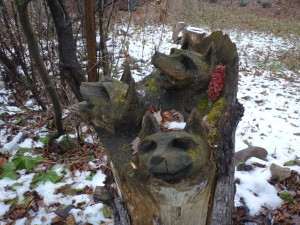
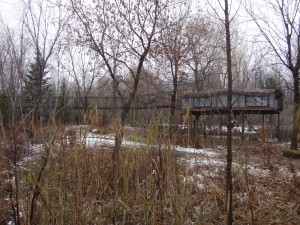
At the end of one of the treetop walkways is this ‘veranda’ area (pictured). It looks out over a pond. Glenn our guide, points out a chimp named Spock lounging inside with a blanket. When he starts speaking to the chimps, they start calling back. It’s a strange thing to hear that distinctive chimp call in the treetops of Quebec! Glenn also suggests my boyfriend may want to remove his hat. (Apparently, hats are kind of a turn-on for Spock. Hah!)
As we move inside the main structure, the chimps who had been outside come in too…curious about their new visitors!
Like most human homes, the kitchen often becomes the hub of activity and here it’s no different. Except you’ve got chimpanzees to please and naturally, their manners might be slightly less refined. The cages face a large island and volunteers wheel food-laden trolleys to a small opening that the chimps can reach their hands through. If they don’t like what’s on the menu – you’ll know it! Pushing trolleys away or tossing items off the tray is a frequent (and comical!) occurrence here. And be vigilant – you might also be on the receiving end of an well-aimed arc of water, right from a chimp’s mouth!
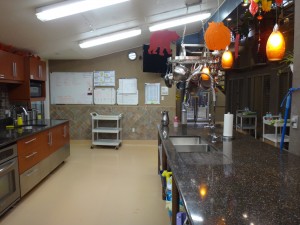
Tatu, is one of the newest chimps here. She is from a sanctuary in Washington and part of a group of chimps that was taught American Sign Language. She signs to go in and out of rooms. She signs the word for “friend” in reference to other chimps. While we are there, she signs emphatically for “milk”. Her request is fulfilled (twice) – and she is thrilled.
On our visit, apples are the highlight of the kitchen and Binky (from a now defunct research lab in New York City) is casually chewing a plastic candy wrapper in addition to an apple. Concerned he’ll swallow the plastic, Glenn tells Binky he can have 2 apples if he trades the wrapper for it. After some moments of contemplation, Binky takes the plastic out of his mouth, places it on the trolley in front of the cage and extends his hand for a double-apple reward.
It’s a huge financial endeavour to feed this many primates. The Foundation goes thru $1000 -$1300 worth of fresh food every single week. Not including the extra chimp goodies they purchase like nuts and soy milk. The food is carefully balanced with necessary calories and vitamins – providing the chimps about 2000 calories/day. They even get regular speciality dishes – like stuffed peppers, brownies and smoothies! To keep them engaged and stimulated, food is presented in interesting ways – like cereal (with spoons) and even squirt guns full of juice!
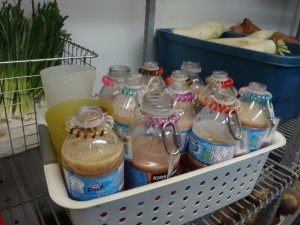
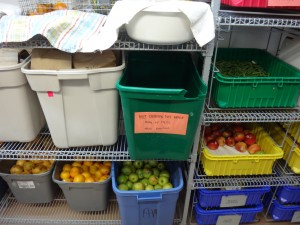
Standing here at the epicentre of an audience of chimps – you soon realize that you’re the one on display. They eye us with as much curiosity as we do them. Glenn mentions the silence is a good indication that the apes approve of our being there (what a nice feeling!). The chimps will sound off if they perceive a ‘bad’ person (after all, they had experience with all kinds of bad people before they came here) – and that person will be asked to exit the building, so as not to stress the group. The wellbeing of animals takes priority – always.
Distance is crucial. Even though chimps can share space and create friendships with one another, human-ape interaction is only ever through cage bars. Chimps are wild animals, these ones weighing from 120 to 280 pounds. They possess 7-10 times the strength of a human in their arms alone. No matter the temptation, no matter the bond, direct access to humans could have disastrous consequences. There are warnings everywhere. Well-trained volunteers (it takes a year of training and dedication for the privilege to work in the chimp house), feed, play games and interact with animals through the bars. The apes reach fingers out for caresses and to touch their caretakers. There is a deep respect for these animals not only as innately wild creatures but also as individuals who have experienced profound trauma in their past.
Like Sue Ellen.
Sue Ellen, now 46, was a pet. Raised as a human child, wearing clothing, riding in cars, making money for her owner through use in the entertainment industry. At the age of 15, she was chauffeured to a research lab. She was sold, thrown in a tiny steel cage and subjected to unspeakable invasive abuses at the hands of humans for years. She was rescued by Fauna in 1997. It’s like having lived 3 separate lives in the span of 46 years – and only the latter with respect, kindness and love.
Chimp faces are as unique as they come. And their preferences as well! Like Petra who can always be seen wearing her necklace of keys (which she tries daily to fit into locks). Toby who adores cooked beets! Binky likes playing with soap bubbles. Rachel is a fan of hairbrushes, and will groom with them.
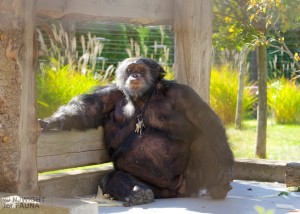
Photo Credit: NJ Wight
www.njwight.com
Individuals.
For me, being so close to these sentient, powerful and intelligent creatures is an honour. But there is an underlying sadness, that I’m sure is shared by all who work and visit here. For all the joy you derive in seeing them up close, for all the love and care they get, it’s a heartbreaker to realize you really shouldn’t be seeing them in this way.
These chimps were robbed so long ago of a life they deserved. They watched family members murdered, so they could be captured in the wild as babies. They were curiosities in cramped, public zoo environments. These social and loving creatures were isolated and misunderstood. Many of their bodies have been so abused by lab experiments, they are in chronic pain. Even with the top-notch vet care they receive here, there will never be a way to medically repair things like organs that have been brutalized to the point of no return. In many ways, this is palliative care.
Fauna endeavours to soothe the pain – not only of broken bodies, but of broken spirits. It functions with such excellence on so many levels, you can’t help but be awed. To me – Fauna Foundation is a true example of how rescues should operate. Doing things responsibly and ethically – with unwavering commitment and professionalism. Ensuring that each and every animal, as far as captivity can allow – not just has “food and shelter” – but has everything it requires for an emotionally fulfilling life. And in lieu of fanaticism – promoting education, kindness, and the type of positive outreach that fuels positive action.
Thank you for an unforgettable experience.
____
Chimps are not used in medical research in Canada. The U.S. continues to use primates for research in places like New Iberia (Louisiana), Yerkes (Georgia) and Southwest Biomedical (Texas), among others.
How you can help:
Deepest thanks to the following people for their involvement in this article and visit:
Gloria Grow
Richard Allan
Glenn Grow
Trina McKellar
Mary Lee Jensvold
Learn More:
 Montreal Dog Blog Montreal's Online Dog Park
Montreal Dog Blog Montreal's Online Dog Park




